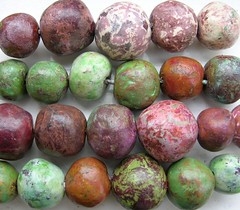I could feel every muscle group in my body complain as I continued brushing away the loose, fine dirt to reveal more ash and charcoal in my locus. My legs were thanking me for kneeling in one place, but for the last week I had been hauling buckets and wheeling loads of topsoil non-stop. I had finally been moved to the locus I was meant to stay in for the remainder of the dig, which, after moving about 6 inches of topsoil, we discovered was the site of a collapsed wall. We spent two days hauling rocks that seemed as big as I was to reveal whatever crushed history might be beneath. Meanwhile, my body was rebelling against everything: the dust in my lungs, the smell of the neighboring waste-processing plant, the oppressive, arid heat, and the arduous physical labor. But now, now I was doing more restful, detailed work. I climbed out of my square to finish downing my third liter of water for the morning.
Gretchen, a several-season volunteer at the Tiberias dig, stopped documenting finds momentarily to quip, "If anyone thinks that archaeologists sit around in holes all day with toothbrushes and delicate tools, they have been reading too much National Geographic." Upon hearing this, I promptly set my water bottle on the dry ground, raised my hand and announced, "I have been reading too much National Geographic!" Gretchen and the volunteers looked up at me, surprised, but then began to laugh loudly and nod their heads in empathy. It was evident that I hadn't been alone in my dreamworld.
Needless to say, archaeology did not quite meet my expectations. I don't consider this a strike against my digging experience at all, but against my preconceived ideas of what it would be like. It was hard work, but the ache in my muscles as I crashed into my bed every night was a testimony to my investment in the dig. There is something infinitely satisfying about going to bed both body- and mind-tired, knowing that your entire self has been poured into a work that you care about. Hauling gigantic rocks out of my square was some of the most difficult work I've done, but surveying the pile of rocks triumphantly has been one of my proudest moments.
The hard work was well worth it, not only in an esoteric or community-driven sense, but for my own personal experience. I learned about the process of archaeology and the tools required, and a great deal about the history of the area as well the Late Islamic Period. Still, the media- (or perhaps National Geograhic-)saturated Sarah was hoping for some magnificent find reminiscent of a Lara Croft or Indiana Jones adventure.
I finally got my glorious moment upon uncovering an 12th-13th century oil lamp in an area that was supposed to be uninhabited by the 11th century. Shouting "YOPHI!" ("beautiful!") upon finding an artifact had become something of a joke among the volunteers. I finally had my own turn to whisper, "yophi," as I brushed around this lamp and began recognizing its intact shape, despite its location beneath a collapsed wall. I am willing to accept that perhaps it wasn't quite as epic as finding the ark of the covenant. Still, the excited look on my dig director's face as she tried to reformulate her ideas about the history of the mosque complex made me feel it was just as significant...however illogical that may be.
Was it fun? Sometimes, but most certainly not always. But was it fulfilling, significant, enriching, stretching? Oh, yes. Yes, it was.




